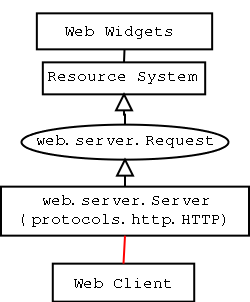
Twisted Web is a web application server written in pure Python, with APIs at multiple levels of abstraction to facilitate different kinds of web programming. The most useful for web application designers is Web Widgets, a high-level class-and-template oriented system. There is also the Resource system, which Web Widgets is built on.

When the Web Server receives a request from a Client, it creates a Request object and passes it on to the Resource system. The Resource system dispatches to the appropriate Resource object based on what path was requested by the client. The Resource is asked to render itself, and the result is returned to the client.
Resources are the lowest-level abstraction for applications
in the Twisted web server. Each Resource is a 1:1 mapping with
a path that is requested: you can think of a Resource as a
single page
to be rendered. The interface for making
Resources is very simple; they must have a method named
render which takes a single argument, which is the
Request object (an instance of twisted.web.server.Request). This render
method must return a string, which will be returned to the web
browser making the request. Alternatively, they can return a
special constant, twisted.web.server.NOT_DONE_YET, which tells
the web server not to close the connection; you must then use
request.write(data) to render the
page, and call request.finish()
whenever you're done.
Web Widgets are an added layer of abstraction of Resources -- they're much nicer for most sorts of web applications. For more information on Widgets, see Introducing Web Widgets.